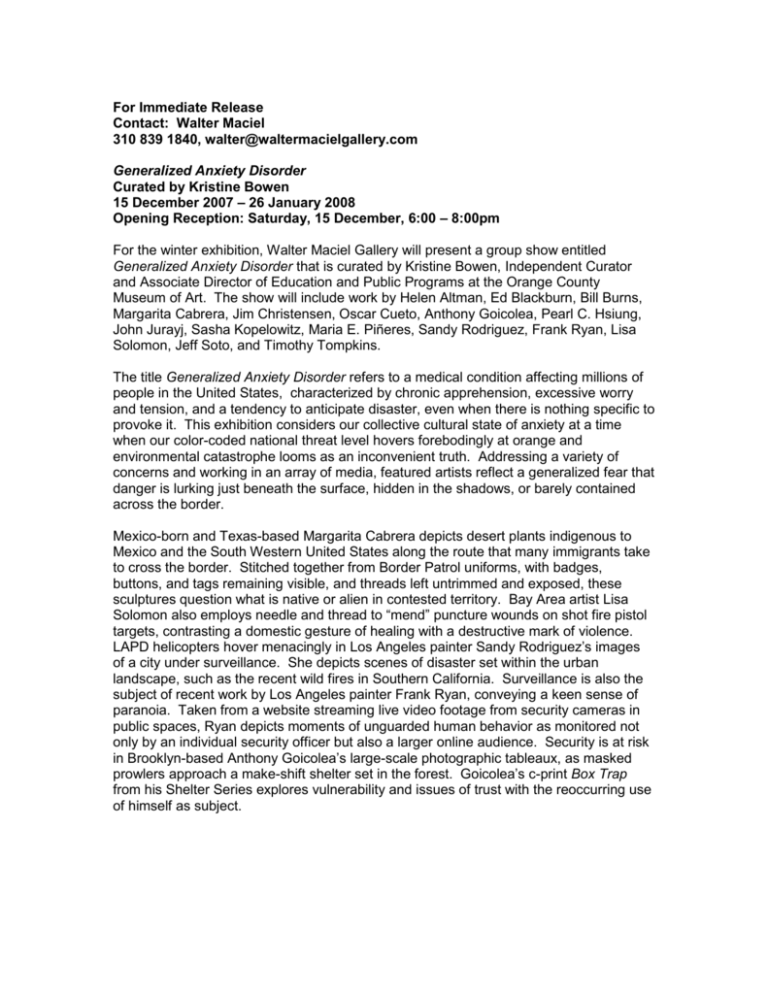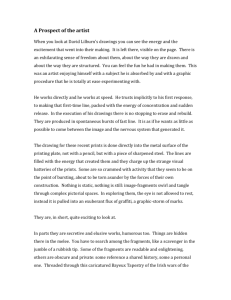Press Release - Walter Maciel Gallery
advertisement

For Immediate Release Contact: Walter Maciel 310 839 1840, walter@waltermacielgallery.com Generalized Anxiety Disorder Curated by Kristine Bowen 15 December 2007 – 26 January 2008 Opening Reception: Saturday, 15 December, 6:00 – 8:00pm For the winter exhibition, Walter Maciel Gallery will present a group show entitled Generalized Anxiety Disorder that is curated by Kristine Bowen, Independent Curator and Associate Director of Education and Public Programs at the Orange County Museum of Art. The show will include work by Helen Altman, Ed Blackburn, Bill Burns, Margarita Cabrera, Jim Christensen, Oscar Cueto, Anthony Goicolea, Pearl C. Hsiung, John Jurayj, Sasha Kopelowitz, Maria E. Piñeres, Sandy Rodriguez, Frank Ryan, Lisa Solomon, Jeff Soto, and Timothy Tompkins. The title Generalized Anxiety Disorder refers to a medical condition affecting millions of people in the United States, characterized by chronic apprehension, excessive worry and tension, and a tendency to anticipate disaster, even when there is nothing specific to provoke it. This exhibition considers our collective cultural state of anxiety at a time when our color-coded national threat level hovers forebodingly at orange and environmental catastrophe looms as an inconvenient truth. Addressing a variety of concerns and working in an array of media, featured artists reflect a generalized fear that danger is lurking just beneath the surface, hidden in the shadows, or barely contained across the border. Mexico-born and Texas-based Margarita Cabrera depicts desert plants indigenous to Mexico and the South Western United States along the route that many immigrants take to cross the border. Stitched together from Border Patrol uniforms, with badges, buttons, and tags remaining visible, and threads left untrimmed and exposed, these sculptures question what is native or alien in contested territory. Bay Area artist Lisa Solomon also employs needle and thread to “mend” puncture wounds on shot fire pistol targets, contrasting a domestic gesture of healing with a destructive mark of violence. LAPD helicopters hover menacingly in Los Angeles painter Sandy Rodriguez’s images of a city under surveillance. She depicts scenes of disaster set within the urban landscape, such as the recent wild fires in Southern California. Surveillance is also the subject of recent work by Los Angeles painter Frank Ryan, conveying a keen sense of paranoia. Taken from a website streaming live video footage from security cameras in public spaces, Ryan depicts moments of unguarded human behavior as monitored not only by an individual security officer but also a larger online audience. Security is at risk in Brooklyn-based Anthony Goicolea’s large-scale photographic tableaux, as masked prowlers approach a make-shift shelter set in the forest. Goicolea’s c-print Box Trap from his Shelter Series explores vulnerability and issues of trust with the reoccurring use of himself as subject. Fort Worth-based Ed Blackburn represents current media events in highly charged prints and drawings. Blackburn’s comic-style images of politicians engaged in authoritative posturing questions power and its exploitation. President Bush, for example, is portrayed with a stern and distorted facial expression as he warns congress not to dictate power. Southern California painter Timothy Tompkins also pulls his subjects from the headlines, while referencing art historical sources. The composition and palette of his enamel on aluminum painting 9.7.06 (after David) suggest Jacques-Louis David’s Consecration of the Emperor Napoleon I and the Coronation of the Empress Josephine, while the image originates from a New York Times photo of Bush delivering a speech in the East Room of the White House justifying the CIA’s secret prisons for terror suspects. Los Angeles artist Maria E. Piñeres’ needlepoint drawing on perforated paper captures a distorted and doubled Osama bin Laden, one in a series of palindromes. John Jurayj paints images of the destruction and chaotic state of Lebanon, his father’s homeland. The Brooklyn-based artist’s gestural brushwork mirrors the explosive subject of his work: the bombing of the American Embassy in Beirut. Jeff Soto’s work also considers conflict, especially those that arise when humans take advantage of nature. The Southern Californian artist’s recent painting on paper depicts an aerial perspective of an oversized military helicopter pointed downwards toward a suburban home with an oil rig looming in the background, drawing a neat triad between our dependency on natural resources and war. Using a torch to burn delicately rendered drawings of wild animals on paper, Texas artist Helen Altman’s work suggests a natural world on the brink of peril, scorched by a human hand. She also explores issues of confinement and limited space with her sculpture consisting of a small fish bowl with several artificially made gold fish peering out with bulging eyes. Toronto-based artist Bill Burns guards against natural catastrophe in his Safety Gear for Small Animals. His miniature work gloves, hard hat, and flotation device promise protection for wildlife in a time of uncertainty. Southern California artist Pearl C. Hsiung’s graphic yet surreal landscapes include elements that mimic bodily characteristics, such as a toothy mouth opening within a looming cloud. Her anthropomorphic environments in toxic colors confront the viewer as though a predator facing prey, suggesting a world gone horribly awry. Jim Christensen lives in New York but his recent work explores his past living as a young boy in southern Florida. Meticulously drawn in graphite, his drawings portray mysterious alligators lurking in vast expanses of murky dark space. The alligator becomes the artist’s muse, evoking an ambiguous future and anxiety about the unknown. Similarly self-reflective, New Yorker Sasha Kopelowitz paints intricate abstractions that give form to libidinal chaos, embodying both the terror and exuberance of these turbulent times. Her work suggests a constant state of tension in striking a balance between the delicate and grotesque, chaos and order, and body and spirit. Mexico City-based Oscar Cueto’s video self-portrait parodying the art world depicts the anxiety of the artist. In one animation rendered from several hundred frame to frame drawings, the artist is portrayed as a mute and innocent victim harassed and beaten by ten of his closest friends in the short entitled 10 Bad Reviews. The agitated mob reflects the fickle and rancorous temperament of today’s culture.







